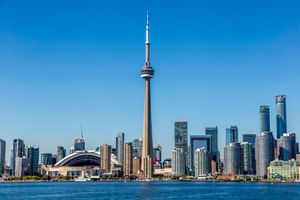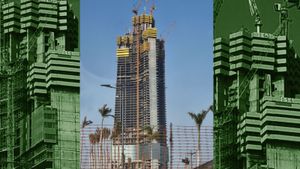As Âstrong as iron yet as delicate as lace, the Eiffel Tower is the romantic symbol of Paris. Interestingly, its design was at first disdained by the city's artists and writers, who protested the tower's construction in 1889 for the Universal Exposition, a world's fair commemorating the 100th anniversary of the French Revolution. Eventually, however, the tower's beauty, originality, and engineering wizardry won it widespread praise and affection -- as well as a place on the canvases of artists such as Pissarro and Utrillo.

©Shutterstock
The City of Light finds its loveliest expression in the Eiffel Tower by night -- one of the most romantic views on earth.
See more pictures of famous landmarks.
Bridge engineer Gustave Eiffel designed the tower, exulting that "the French flag is the only one with a 300 meter pole." (At 984 feet, the tower ranked as the world's tallest structure for decades; modern television transmitters on top have elevated it to the present 1,063 feet.)
Eiffel's drawings were so precise, giving details for more than 18,000 metal parts, that the tower was erected in just a little more than two years. An astounding 2.5 million rivets hold the parts together, and the tower weighs in at 14.6 million pounds (7,300 tons). Repainting the tower -- a job that requires 50 tons of paint -- is done every seven years.
To reach the top, visitors take elevators that follow curving paths up the legs of the tower. Each year the lifts travel more than 60,000 miles. The cars need special brakes to adapt to the varying angles of descent; a crew of employees crafts replacement parts for the elevators by hand.
The tower has three platforms, and energetic visitors can tackle climbing the stairs to the first two, reached at 187 feet and 377 feet. From the topmost platform at 899 feet, the panorama can stretch for some 50 miles on a clear day. It has been said that the streets and environs of Paris below unfold like a giant map.
Visitors reaching the top can peek into Eiffel's own salon. On their way up or down, they can choose to dine elegantly at the Jules Verne restaurant, which serves a seasonal menu of traditional French cuisine. The food nearly matches the view -- and the prices definitely match the height of the tower.

©Wikipedia PD
A great deal of criticism swirled around the Eiffel Tower during construction. Guy de Maupassant ridiculed it as a "high and skinny pyramid of iron ladders," while novelist Leon Bloy labeled it a "truly tragic street lamp."
Patrons look down at the green lawn known as the Champs de Mars, formerly a parade ground for the 18th-century École Militaire, a military academy housed in a neoclassical building at the end of the lawn. One famous graduate of the class of 1785: Napoléon.
While you're high atop the Eiffel Tower, it's comforting to know that the structure was engineered to sway no more than five inches in a strong wind. Even more remarkable, the tower actually "grows" up to nearly six inches during hot weather -- a result of metal expansion.
The tower was never meant to be a permanent installation on the Paris skyline, and it was nearly dismantled in 1909. Only the emerging field of radio telegraphy saved it -- antennas mounted on the tower proved vital to French transmissions. Over the decades since then, the tower has played important roles for the International Time Service, transatlantic radio telephone service, radio broadcasting, and French television.
Up Next
|
The view from the top of the Eiffel Tower is particularly enchanting in the evening, when city lights glitter on the Seine and romance fills the air. The structure itself is lighted from within, flooded with a radiance that transforms the tower into a jewel box of silver and gold. New lights were installed as part of a major facelift the tower received in 1986, prior to the observance of its 100th birthday in 1989. A great deal of rust was removed during the work, restoring the tower to a gleaming appearance in daytime as well.
Although the panorama of the city from on top can't be surpassed, the best view of the tower itself is from below. If you position yourself between the tower's feet and look up, you'll appreciate the grace of the iron latticework and see a dramatically distorted perspective of the tower soaring overhead. You'll be sharing this experience with other people from all over the world: Each year the Eiffel Tower draws some six million admirers wanting to see the world-famous symbol of Paris. Its perennial popularity is assured.
Here are links to dozens of other world-famous landmarks:
| Abu Simbel, Egypt | History of France ABOUT THE AUTHOR: Jerry Camarillo Dunn Jr., has worked with the National Geographic Society for more than 20 years, starting as a staff editor, writer, and columnist at Traveler magazine, then writing travel guides. His latest work is National Geographic Traveler: San Francisco. Dunn’s Smithsonian Guide to Historic America: The Rocky Mountain States has sold more than 100,000 copies. His travel pieces appear in newspapers such as the Chicago Tribune and The Boston Globe. Jerry Dunn's stories have won three Lowell Thomas Awards from the Society of American Travel Writers -- the highest honor in the field. He also wrote and hosted a pilot episode for a travel show produced by WGBH, Boston's public television station. Advertisement Advertisement
Loading...
|











